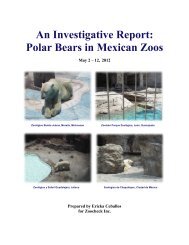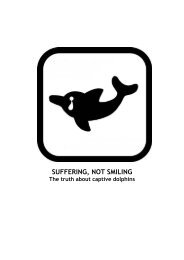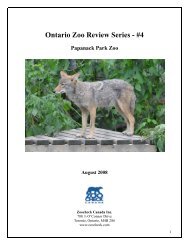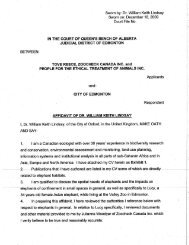Ontario Zoo Review Series - #6 - Zoocheck Canada
Ontario Zoo Review Series - #6 - Zoocheck Canada
Ontario Zoo Review Series - #6 - Zoocheck Canada
You also want an ePaper? Increase the reach of your titles
YUMPU automatically turns print PDFs into web optimized ePapers that Google loves.
<strong>Ontario</strong> <strong>Zoo</strong> <strong>Review</strong> <strong>Series</strong> - <strong>#6</strong><br />
Northwood <strong>Zoo</strong> and Animal Sanctuary<br />
August 2008<br />
<strong>Zoo</strong>check <strong>Canada</strong> Inc.<br />
788 ½ O’Connor Drive<br />
Toronto, <strong>Ontario</strong>, M4B 2S6<br />
www.zoocheck.com<br />
1
ZOOCHECK CANADA INC.<br />
<strong>Zoo</strong>check <strong>Canada</strong> is a national animal protection charity (#13150 2072 RR 0001) established in 1984 to promote<br />
and protect the interests and wellbeing of wild animals.<br />
Policy<br />
<strong>Zoo</strong>check objects in principle to the keeping, confinement, use, exhibition and performance of wild animals in<br />
captivity as captivity is not in the best interests of those animals 1 . Nor does the exhibition of live wildlife<br />
provide a positive educational experience for the general public. Wild animals removed from their natural<br />
environment and ecological context bear little or no meaningful resemblance to their counterparts in the wild.<br />
Nonetheless, animals are kept in zoos and similar captive situations at present and for these animals,<br />
improvements in the conditions to which they are subjected are urgently needed. <strong>Zoo</strong>check believes the onus<br />
must be on the owners/operators of facilities who choose to keep these animals captive, to provide for them the<br />
best possible care in the circumstances.<br />
The Investigation<br />
This report provides an overview of the Northwood <strong>Zoo</strong> and Animal Sanctuary in Seagrave, <strong>Ontario</strong> on August<br />
24, 2008. It is the third in a series of investigative reports aimed at providing a snapsnot image of the current<br />
status of captive wild animals in <strong>Ontario</strong>.<br />
Investigator Profile<br />
In 1978 Else Poulsen received her BSc. in Biology from Brock University and in 1995 her 4 year Diploma in<br />
<strong>Zoo</strong>keeping from the City of Calgary Apprenticeship Programs. She has dealt with variety of animal species, in<br />
her work as a field biologist in Alberta’s energy industry, as a zookeeper at the Calgary <strong>Zoo</strong>, and as a bear<br />
specialist in several other facilities.<br />
She has provided expert assistance and advice about modernizing bear husbandry methods, environmental<br />
enrichment programming and enclosure design issues to zoos, sanctuaries and animal welfare groups around the<br />
world.<br />
Poulsen has more than 40 papers and articles to her name in scientific research and technical journals, textbooks<br />
and other publications. She consults as an animal behavior and captive environment trouble-shooter. She has<br />
also lectured on modern bear care and animal welfare issues to audiences as diverse as university students<br />
studying population genetics to First Nations Band Council members in northern <strong>Canada</strong>.<br />
1 In limited circumstances, exclusively for the purpose of benefiting the individual animal or species, <strong>Zoo</strong>check <strong>Canada</strong><br />
supports the keeping of wild animals in captivity as part of a legitimate rehabilitation and release program, or for nonreleasable<br />
animals that have been retired or rescued, or that are part of a legitimate captive propagation initiative, provided<br />
the animal's physical, psychological and social needs are addressed as the primary concern.<br />
2
THE SITUATION IN ONTARIO<br />
There are currently few rules governing the operation of zoos and other kinds of captive wildlife displays in<br />
<strong>Ontario</strong>. This lack of regulation has resulted in a proliferation of zoos and zoo-type exhibits in the province.<br />
<strong>Ontario</strong> has more of these facilities than any other province, including many of the worst in <strong>Canada</strong><br />
Unlike many other jurisdictions, in <strong>Ontario</strong>, non-indigenous exotic wildlife species are not regulated. Virtually<br />
anyone can acquire exotic wild animals, house them in conditions of their choosing and then open up for public<br />
viewing. There are no laws or regulations requiring the owners or operators of zoos to have expertise or<br />
experience in wild animal care, the financial resources to properly operate their facility or an ability to conduct<br />
their business in a humane and safe manner.<br />
"Specially protected and game wildlife," defined as native wildlife listed in the Fish and Wildlife Conservation<br />
Act, can only be kept and displayed if a license to do so has been obtained from the <strong>Ontario</strong> Ministry of Natural<br />
Resources (MNR). Three general animal welfare conditions are attached to all licenses, but they are not specific<br />
and are open to interpretation, so enforcement is problematic.<br />
<strong>Ontario</strong>’s lack of zoo licensing and comprehensive wildlife in captivity standards has resulted in a large number<br />
of zoos and wildlife menageries operating at a standard of their own choosing. There is nothing in place that<br />
specifically addresses the many issues associated with the capture, breeding, keeping and display of wild animals<br />
in zoos and zoo-type exhibits.<br />
The unfettered proliferation of wild animal displays in <strong>Ontario</strong> has been recognized as a problem for<br />
approximately 30 years. Numerous measures to deal with this issue have been initiated, but none have been fully<br />
supported by government, so the captive wildlife industry remains essentially unmonitored and uncontrolled to<br />
this day.<br />
The Government of <strong>Ontario</strong> has the ability to create a regulatory regime for all wildlife in captivity that is<br />
consistent with other jurisdictions, comprehensive, fair to license holders and respectful of the many individual<br />
animals whose lives are directly affected by it. In addition to numerous workable and adaptable models being<br />
available in other jurisdictions, in 2001, the MNR published its own set of standards for zoos.<br />
Comprehensive Licensing and Regulation is Required<br />
The <strong>Ontario</strong> government should implement and administer a comprehensive zoo and wildlife in captivity<br />
regulatory program that requires anyone holding native and/or exotic wild animals in captivity to obtain a license<br />
and to satisfy a series of conditions as to their knowledge, experience, financial abilities, wild animal housing<br />
and management practices, safety procedures and other relevant issues. Licenses should be issued annually and<br />
only after an inspection of the premises to be licensed is conducted. The regulatory program should include the<br />
ability to conduct special inspections, penalties for non-compliance and provisions for license revocation.<br />
Bill 50, An Act to amend the <strong>Ontario</strong> Society for the Prevention of Cruelty to Animals Act<br />
In 2008, the <strong>Ontario</strong> government introduced Bill 50, An Act to amend the <strong>Ontario</strong> Society for the Prevention of<br />
Cruelty to Animals Act. During the buildup to the introduction of the Act, government officials and elected<br />
representatives said the Act would deal with a variety of animal welfare issues, including roadside zoos.<br />
Bill 50 would:<br />
• Make it a provincial offence to abuse any animal. <strong>Ontario</strong> is the only province where it is not an offence<br />
to abuse most animals. It is only an offence to abuse cats and dogs in commercial breeding operations.<br />
• Establish penalties including a lifetime ban on owning animals.<br />
3
• Allow the <strong>Ontario</strong> SPCA to inspect roadside zoos and other facilities that keep animals. Currently,<br />
anyone can refuse to show the <strong>Ontario</strong> SPCA their animals.<br />
• Establish animal care standards and make failing to comply with these an offence.<br />
While Bill 50 contains a number of very positive features and will significantly improve the existing <strong>Ontario</strong><br />
SPCA Act, it will not address most of the problems that have been identified in zoos and zoo-type exhibits<br />
across the province.<br />
Even though the <strong>Ontario</strong> government has repeatedly indicated its intent to deal with wildlife in captivity issues<br />
through Bill 50, there are currently no standards or regulations being proposed at this time. If standards of some<br />
kind are developed in future, they will not contain up front licensing of zoos and zoo-type exhibits that screen<br />
persons wanting to own wild animals or open public displays. Standards promulgated under Bill 50 will be<br />
enforced retroactively after animals have been acquired or a zoo or wildlife display opened.<br />
If, as the Government of <strong>Ontario</strong> has stated, <strong>Ontario</strong> is to move from "worst to first" in animal protection, then<br />
Bill 50 must include comprehensive regulations for zoos. With the weakest zoo regulations in the country,<br />
<strong>Ontario</strong> is the only province that does not require zoos and zoo-type facilities to meet specific public safety<br />
requirements and does not require residents to obtain a license to keep exotic wild animals.<br />
The lack of appropriate laws and regulations, and the difficulties inherent in enforcing the existing relatively<br />
minor welfare provisions attached to licenses issued under the Fish and Wildlife Conservation Act, mean that<br />
<strong>Ontario</strong>’s zoos and wildlife exhibits go more or less unchecked. This has left a need for independent animal<br />
welfare agencies, such as <strong>Zoo</strong>check <strong>Canada</strong> and the World Society for the Protection of Animals (WSPA), to<br />
proactively and comprehensively monitor and evaluate these facilities for concerns of human health and safety<br />
and animal welfare.<br />
4
COMMENTARY – Northwood <strong>Zoo</strong> and Animal Sanctuary<br />
General<br />
The Northwood <strong>Zoo</strong> and Animal Sanctuary (changed from its previous name of Northwood Buffalo and Exotic<br />
Animal Ranch) describes itself as “a non-profit sanctuary,” but they appear to be neither non-profit or a<br />
sanctuary.<br />
The facility advertises trained animals for “film, still photography, parties, television, community and corporate<br />
events, commercials, and business gatherings” on its website. As well, a red vehicle advertising “Predator<br />
Productions” was observed on the property during my visit. The telephone number on the side of the vehicle was<br />
the home number for Tony Vanzuilekom, Northwood’s head zookeeper.<br />
The generally accepted definition of a sanctuary is a facility where animals, usually rescued from poor<br />
conditions, live out their lives in natural environments and appropriate social groupings, and they are not<br />
typically on public display, except under very controlled circumstances. As well, they are not bred, trained to<br />
perform or used in commercial activities.<br />
On the Northwood website, it states, “If your production calls for something [animals] we don’t have, we will<br />
find it – [through their] extensive lists of contacts with our professional animal sources – providing our clients<br />
with any animal they need.” This clearly is not in line with normal sanctuary operations.<br />
The website also states, “Northwood is a Non-Profit Sanctuary Dedicated to providing a clean, safe and loving<br />
environment to over 100 exotic animal species. Including Tigers, Lions, Primates, Bears, Wolves, Buffalo,<br />
Eagles, Owls and other wonderful creatures…Here they are provided the care and respect they deserve so that<br />
they may live out their lives with dignity. We have a responsibility to provide for them the best life possible.<br />
Hopefully, despite some of their respective backgrounds, they can learn to trust people again.”<br />
Despite the Northwood <strong>Zoo</strong> and Animal Sanctuary proclaiming itself to be both a zoo and a sanctuary, it seems<br />
clear the facility is primarily a commercial operation.<br />
Animal Husbandry and Welfare<br />
The facility is situated in a predominantly agricultural area of open fields. Most of the large enclosures,<br />
including those containing bison, brown bears, tigers, and lions, have no trees or significant shade areas. Several<br />
enclosures, including those confining wolves and cougars, are reminiscent of large, outdoor, kennel-type runs.<br />
The birds of prey are housed in corncrib-style cages, while the majority of the primates live in a row of old-style<br />
rectangular cages attached to a building structure that provides them with some interior shelter. Other cage<br />
structures housing midsize cats are generally square or rectangular in shape. These are simplistic in design and<br />
not constructed with the species-specific needs of the animals in mind.<br />
All enclosures that I observed have earth substrates, except for the Snow and Amur leopards, that were in barred<br />
cages with cement floors elevated above ground level.<br />
All cages and enclosures were relatively barren and lacked species-specific enrichment, sufficient appropriate<br />
furnishings or privacy areas that allowed the animals to retreat from public view or the view of conspecifics.<br />
Most enclosures had small den structures that appeared in some cases to be insufficient to contain the number of<br />
animals in the exhibit. For example, a male and female Kodiak bear pair live in an open enclosure with a small<br />
pond. The female showed clear signs of being fearful of the male bear and kept her distance from him during<br />
feeding, waiting to catch her “airborne” food (being thrown in by the zookeeper) after the male got his and<br />
walked away from the feeding site. After feeding the female stayed on the opposite side of the pond from the<br />
5
male. The female bear waved her paw at the zookeeper to get her food; it appeared as though she had been<br />
trained to perform this trick.<br />
After the feeding, the zookeeper stayed to answer questions. He said:<br />
• They do not clean up in the enclosures as they believe in the “natural” way of “self cleaning enclosures”<br />
[decomposition] indicating that they have earth substrates.<br />
Since animal territories in the wild are much larger than zoo enclosures, the animals do not typically contact<br />
their own waste. In zoo enclosures, which are orders of magnitude smaller than home ranges in the wild, animals<br />
do contact their own waste. Therefore, feces should be cleaned out periodically. This does not seem to be the<br />
case at Northwoods.<br />
• Animals are fed once a day in single-piled feedings or their food is thrown over the barrier. The zoo<br />
keeper told the crowd that the brown bears are not fed everyday and to “accommodate” denning they<br />
withdraw food on Dec 1 st and do not fed them again until the end of March.<br />
Modern facilities accommodate denning by gradually reducing the quantity of food to stimulate or coincide with<br />
the natural tendency of the bears to lose their appetites as winter approaches. A sudden stoppage of feeding at an<br />
arbitrary point is an outdated husbandry method.<br />
The brown bears are fed together during a public program where the zookeeper throws meat over the fence. The<br />
bears fight for position and are clearly stressed, anxious and in direct competition for food.<br />
While observing this feeding one bear bit another in the left rear flank. I saw a substantial raw, red, superficial<br />
wound on the second bear after the feeding, but I was unable to photograph it. The zookeeper was there but did<br />
not seem to notice the attack.<br />
According to gift store staff, animals are bred and some are removed from their mothers to be hand-raised and<br />
then trained for Predator Productions. They indicated that the three tiger cubs that visitors are able to play with<br />
through the fence were removed for that purpose.<br />
There are a minimum of 12 lions in various enclosures, housed in various groupings or singly. One group is a<br />
“pride” consisting of one male, two adult females (mother and daughter), and three cubs. Gift shop staff said<br />
their breeding was accidental. Lions are social animals that should be kept in a natural social context. Since they<br />
are already in a surplus situation in captivity, they should not be allowed to breed.<br />
Several primate species, including vervet monkeys, lion-tailed macaques, Celebes crested macaques, and whitehanded<br />
gibbons, were housed in rudimentary, relatively barren cages with minimal perching, where I observed<br />
them sitting or lying. Some were inappropriately housed alone, while others were in pairs or small groups.<br />
Northwoods also houses wildlife species native to <strong>Ontario</strong>, including an American black bear, cougar, bobcat,<br />
lynx, fox and wolves. They are licensed by the <strong>Ontario</strong> Ministry of Natural Resources (OMNR) as a zoo. The<br />
OMNR should require this facility to improve the level of stimulation provided to these animals, particularly<br />
through various modes of environmental enrichment.<br />
In general, the animals had nothing to do, so they did nothing except recline and stare out of their cages. I did<br />
observe several animals pacing and many of the enclosures had grooved, well worn pacing paths along their<br />
interior fence lines. This is typically a sign of animals that are bored and/or frustrated.<br />
Northwoods also advertises its role in the European Snow leopard and Amur leopard SSP (Species Survival<br />
Plan). The SSP however is an American-based program, while endangered species breeding programs in Europe<br />
are known as EEPs. Regardless, the keeping of single individuals in old-style, raised, cement floored cages that<br />
6
are devoid of appropriate structural enhancements, furnishings, enrichment, bedding and privacy does nothing to<br />
contribute to conservation.<br />
Animal and Human Safety<br />
The gauge of wire used in the fencing for several large carnivores and bison appears inappropriately light. For<br />
example, one tiger is confined behind what appears to be a standard chain-link fence with significant gaps under<br />
the entry gate. Most zoos recognize that heavier gauge mesh is best for large, potentially dangerous animals.<br />
Some of the primary barriers are not nearly high enough. For example, the brown bear fence is only about 2.4m<br />
(8 ft) high and is not equipped with an inwardly angled upper segment to discourage climbing. Hot-wires seem<br />
to be the primary method for containing the bears, but they are not usually recommended as primary barriers for<br />
these animals. The lion, tiger and wolf enclosure fences were also extremely low. I expect that if properly<br />
motivated the animals could climb or jump out.<br />
I was unable to determine whether there was any buried fencing in the cat and bear enclosures to prevent digging<br />
underneath the barrier. I did not observe any.<br />
The brown bears were fed by the zoo keeper throwing food items over the fence causing stress and conspecific<br />
aggression.<br />
One cougar enclosure had a square opening in the gate (presumably so the zookeeper can feed the animal) that<br />
was covered with only a rubber flap. This is potentially dangerous to the zookeeper as the cat can paw at the<br />
keeper through the opening. In one cougar enclosure, the cat had begun to dig under the fence.<br />
I did not observe any double-door entry gates into animal areas that allow an outer door to be closed, prior to<br />
opening the door into the actual animal living area.<br />
The emu pen has a roll of fencing in the yard with a number of metal ends sticking out, a potential hazard to the<br />
birds.<br />
<strong>Zoo</strong> visitors are able to reach into numerous cages and enclosures and potentially contact animals. This is both<br />
physically dangerous and, as there do not appear to be any hand-wash stations, there is the potential for disease<br />
transfer from animals to humans.<br />
Public Education<br />
Signs throughout the zoo provide basic information about many of the animals. While it is not consistent, some<br />
signs also contain information about conservation issues as well.<br />
Summary<br />
Northwood <strong>Zoo</strong> and Animal Sanctuary could greatly improve the wellbeing of the animals through a zoo wide<br />
enrichment program involving the introduction of furnishings, objects and various animal management changes,<br />
including modifying their inadequate feeding routines.<br />
There are also numerous physical improvements that can be made to the animal living conditions, including<br />
tilling all hardpan surfaces, providing soft substrate areas for the leopards, phasing out the antiquated caging,<br />
increasing the number of shelter and privacy areas and increasing the amount of space available to the animals.<br />
In addition, if Northwoods truly wishes to be an animal sanctuary, they must stop breeding animals and<br />
removing them to be hand-raised and trained for commercial use.<br />
7
This relatively barren brown bear enclosure has a very low primary barrier<br />
and no substantive shade or privacy areas.<br />
This barrier fence is very light gauge for housing brown bears.<br />
8
The primary barrier fence in this tiger enclosure is far too low.<br />
This corncrib-style bald eagle cage is an inappropriate<br />
design, poorly equipped and provides no stimulation for the birds.<br />
9
This fence on this wolf enclosure is low and not equipped with an overhang at the top.<br />
This snow leopard exhibit is simplistic, poorly equipped and outdated in design.<br />
10
This leopard’s living space is Spartan leaving the cat with very little to do.<br />
This lion enclosure is flat, overly simplistic and surrounded by a very low fence.<br />
11
This cage housed three infant tiger cubs. Tigers are already<br />
overabundant in captivity and should not be bred.<br />
This lion cage is poorly designed and lacks any meaningful enrichment.<br />
12
CONCLUSIONS & RECOMMENDATIONS<br />
This series of investigative reports highlight animal welfare and human safety concerns in zoos and<br />
wildlife displays across the province.<br />
Key problems identified in <strong>Ontario</strong> zoos in 2008 include:<br />
1. Poor animal health and welfare;<br />
2. Undersized, badly constructed, poorly designed cages and enclosures;<br />
3. Inappropriate substrates (floor surfaces);<br />
4. Lack of adequate shelter and privacy;<br />
5. Lack of stimulation (e.g., furniture, objects, other enrichment);<br />
6. Lack of nutritive food and potable water;<br />
7. Inadequate safety and security measures.<br />
Many of these problems have been identified in previous reports by various parties in past years.<br />
Recommendation<br />
Bill 50, An Act to amend the <strong>Ontario</strong> Society for the Prevention of Cruelty to Animals Act is currently<br />
being considered by the Government of <strong>Ontario</strong>. It contains a number of very positive features and will<br />
significantly improve the existing <strong>Ontario</strong> SPCA Act. However, there are currently no standards or<br />
regulations being proposed at this time within Bill 50 or in any other provincial legislation that will<br />
properly address issues associated with the keeping of wildlife in captivity. <strong>Ontario</strong> has the ability to<br />
create a regulatory regime within Bill 50 and in other legislation that is both comprehensive and<br />
workable but, so far, has chosen not to do so.<br />
In order to properly handle the various animal welfare and human safety concerns inherent in the<br />
operation of zoos and wildlife displays, a comprehensive regulatory regime is required. Regulations<br />
must require anyone holding native and/or exotic wild animals in captivity to obtain a license and to<br />
satisfy a series of conditions as to their knowledge, experience, financial abilities, wild animal housing<br />
and management practices, safety procedures and other relevant issues. Annual licenses should only be<br />
issued after an inspection of the premises that is to be licensed is conducted. The regulatory program<br />
should include the ability to conduct special inspections, penalties for non-compliance and provisions<br />
for license revocation.<br />
If, as the Government of <strong>Ontario</strong> has stated, <strong>Ontario</strong>’s animal protection laws are to be brought from<br />
“worst to first,” then Bill 50, An Act to amend the <strong>Ontario</strong> Society for the Prevention of Cruelty to<br />
Animals Act must include comprehensive zoo regulations that adequately and proactively address<br />
animal welfare and human safety concerns in <strong>Ontario</strong> zoos and wildlife displays.<br />
13
















